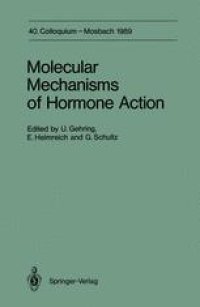
Ebook: Molecular Mechanisms of Hormone Action
- Tags: Biochemistry general, Cell Biology, Cancer Research, Endocrinology
- Series: 40. Colloquium der Gesellschaft fur Biologische Chemie 6.– 8. April 1989 in Mosbach/Baden 40
- Year: 1989
- Publisher: Springer-Verlag Berlin Heidelberg
- Edition: 1
- Language: English
- pdf
Recent years have seen tremendous progress in the field of hormone action and consequent signal transduction. The 40th Colloquium Mosbach was devoted to the discussion of results concerning the molecular process of hormone action, especially the processes following hormone binding to the corresponding receptors. Structural and functional aspects of steroid hormone receptors as well as ion-channel-coupled and enzyme-linked receptors were treated in detail. Particular interest focussed on the latest results concerning transcriptional control, protein phosphorylation, the role of G-Proteins, oncogene proteins, involvement of phospholipases and the regulation of ion channels.
Recent years have seen tremendous progress in the field of hormone action and consequent signal transduction. The 40th Colloquium Mosbach was devoted to the discussion of results concerning the molecular process of hormone action, especially the processes following hormone binding to the corresponding receptors. Structural and functional aspects of steroid hormone receptors as well as ion-channel-coupled and enzyme-linked receptors were treated in detail. Particular interest focussed on the latest results concerning transcriptional control, protein phosphorylation, the role of G-Proteins, oncogene proteins, involvement of phospholipases and the regulation of ion channels.
Recent years have seen tremendous progress in the field of hormone action and consequent signal transduction. The 40th Colloquium Mosbach was devoted to the discussion of results concerning the molecular process of hormone action, especially the processes following hormone binding to the corresponding receptors. Structural and functional aspects of steroid hormone receptors as well as ion-channel-coupled and enzyme-linked receptors were treated in detail. Particular interest focussed on the latest results concerning transcriptional control, protein phosphorylation, the role of G-Proteins, oncogene proteins, involvement of phospholipases and the regulation of ion channels.
Content:
Front Matter....Pages I-XII
Front Matter....Pages 1-1
Mode of Action of Steroid Hormones: A Historical Review....Pages 3-11
Interaction of Steroid Hormone Receptors with DNA....Pages 12-20
Clustered Arrangement and Interaction of Steroid Hormone Receptors with Other Transcription Factors....Pages 21-28
Chromatin Template Remodeling and Steroid Receptor Transactivation of MMTV....Pages 29-34
Hormone-Dependent Transcriptional Activation by Thyroid Hormone Receptors: Functional Homology with Steroid Hormone Receptors....Pages 35-43
Subunit Structure of the Glucocorticoid Receptor....Pages 44-52
Modulation of Glucocorticoid Hormone Action by Oncogenes and Peptide Hormones....Pages 53-60
Studies on the Regulation of Glycogen and Lipid Metabolism by Insulin and Growth Factors: The Involvement of Receptor Tyrosine Kinase Activation and Casein Kinase II....Pages 61-71
Front Matter....Pages 73-73
Genes Coding for G Proteins in Mammalian and Yeast Cells....Pages 75-84
The ras Oncogene Protein....Pages 85-91
Molecular Mechanisms of G-Protein Activation....Pages 92-99
Interaction of Transducin with Retinal cGMP Phosphodiesterase....Pages 100-107
Phosphoinositide Metabolism and Visual Signal Transduction....Pages 108-115
Hormonal Regulation of Phospholipases....Pages 116-123
Front Matter....Pages 125-125
Regulation of Ion Channels....Pages 126-131
The Structure of the Skeletal and Nonskeletal Muscle Calcium Channel....Pages 132-138
Involvement of Pertussis Toxin-Sensitive G-Proteins in the Modulation of Voltage-Dependent Ca2+ Channels by Extracellular Signals....Pages 139-146
Multiple Roles of G Proteins in Coupling of Receptors to Ionic Channels and Other Effectors....Pages 147-177
The Guanylate Cyclase Family....Pages 178-185
Mechanisms for Hormonal Regulation of the Different Isoforms of Guanylate Cyclase....Pages 186-194
Back Matter....Pages 201-204
Catecholamine Receptors: Structure, Function, and Regulation....Pages 195-200
Recent years have seen tremendous progress in the field of hormone action and consequent signal transduction. The 40th Colloquium Mosbach was devoted to the discussion of results concerning the molecular process of hormone action, especially the processes following hormone binding to the corresponding receptors. Structural and functional aspects of steroid hormone receptors as well as ion-channel-coupled and enzyme-linked receptors were treated in detail. Particular interest focussed on the latest results concerning transcriptional control, protein phosphorylation, the role of G-Proteins, oncogene proteins, involvement of phospholipases and the regulation of ion channels.
Content:
Front Matter....Pages I-XII
Front Matter....Pages 1-1
Mode of Action of Steroid Hormones: A Historical Review....Pages 3-11
Interaction of Steroid Hormone Receptors with DNA....Pages 12-20
Clustered Arrangement and Interaction of Steroid Hormone Receptors with Other Transcription Factors....Pages 21-28
Chromatin Template Remodeling and Steroid Receptor Transactivation of MMTV....Pages 29-34
Hormone-Dependent Transcriptional Activation by Thyroid Hormone Receptors: Functional Homology with Steroid Hormone Receptors....Pages 35-43
Subunit Structure of the Glucocorticoid Receptor....Pages 44-52
Modulation of Glucocorticoid Hormone Action by Oncogenes and Peptide Hormones....Pages 53-60
Studies on the Regulation of Glycogen and Lipid Metabolism by Insulin and Growth Factors: The Involvement of Receptor Tyrosine Kinase Activation and Casein Kinase II....Pages 61-71
Front Matter....Pages 73-73
Genes Coding for G Proteins in Mammalian and Yeast Cells....Pages 75-84
The ras Oncogene Protein....Pages 85-91
Molecular Mechanisms of G-Protein Activation....Pages 92-99
Interaction of Transducin with Retinal cGMP Phosphodiesterase....Pages 100-107
Phosphoinositide Metabolism and Visual Signal Transduction....Pages 108-115
Hormonal Regulation of Phospholipases....Pages 116-123
Front Matter....Pages 125-125
Regulation of Ion Channels....Pages 126-131
The Structure of the Skeletal and Nonskeletal Muscle Calcium Channel....Pages 132-138
Involvement of Pertussis Toxin-Sensitive G-Proteins in the Modulation of Voltage-Dependent Ca2+ Channels by Extracellular Signals....Pages 139-146
Multiple Roles of G Proteins in Coupling of Receptors to Ionic Channels and Other Effectors....Pages 147-177
The Guanylate Cyclase Family....Pages 178-185
Mechanisms for Hormonal Regulation of the Different Isoforms of Guanylate Cyclase....Pages 186-194
Back Matter....Pages 201-204
Catecholamine Receptors: Structure, Function, and Regulation....Pages 195-200
....
Download the book Molecular Mechanisms of Hormone Action for free or read online
Continue reading on any device:

Last viewed books
Related books
{related-news}
Comments (0)